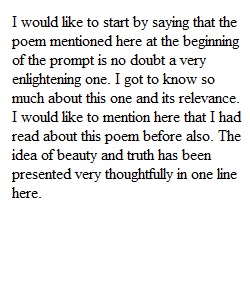


Q Week 13 Discussion 1 Resources Read/review the following resources for this activity: • Textbook: Cahn and Meskin, p. 344-355 Introduction “Beauty is truth, truth beauty,—that is all Ye know on earth, and all ye need to know.” John Keats (1795–1821) from “Ode on a Grecian Urn” Heidegger argues that the greatest value in art lies not in its beauty, but in its truth. The goal of great art is to reveal the “thingly” character – the reliability – of its subjects. He would eschew works made simply to stand and hang in art collections as “objects made for the art industry.” On the other hand, one could not easily argue that Heidegger has alternately provided a justification to ascribe value solely to objets trouvé. Consider the view that the value and very “Being of the work of art lie in its providing a domain within which the world of human purposes and meanings meets the non-human horizon [Heidegger’s earth] of any purposive activity” (Mulhall). In other words, philosophers of art take a myopic view when they focus exclusively on either the meaning or motive for artworks. Initial Post Instructions Do you see Heidegger’s distinction between beauty and truth as a paradox (a seemingly contradictory statement that may nonetheless be true) or a dichotomy (division into two mutually exclusive, opposed, or contradictory parts) or even some other relationship altogether? Depending on the perspective you take in this debate, how closely does his view on the meaning and value of art (especially the inseparable nature of truth) reflect your own? Explain. Secondary Post Instructions Respond to at least one peer and provide a substantive response to his/her postings. Was there consensus/disagreement? Did you gain any new learning? How might you persuade a peer who disagrees with your position to advocate a new point of view? ________________________________________ Writing Requirements • In addition to one initial post, respond to one peer • Initial Post Length: minimum of 300 words • Secondary Post Length: minimum of 300 words per post • Use MLA format for in-text citations and list of references. ________________________________________ Grading and Assessment Meeting the minimum number of postings does not guarantee an A; you must present an in-depth discussion of high quality, integrate sources to support your assertions, and refer to peers’ comments in your secondary posts to build on concepts. Course Learning Outcome(s): 1, 2, 3, 4 1. Defend the value and contribution of aesthetic experiences in human life. 2. Demonstrate an appreciation of art in its different forms. 3. Develop a fluency in fundamental aesthetic concept, theories, and ideas. 4. Synthesize theoretical explanations of aesthetic experience by creating a personal definition and evaluation of art. Due Date for Initial Post: By midnight on Wednesday Due Date for Response Post: By midnight on Sunday
View Related Questions